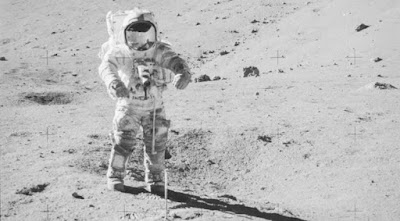Experts will soon open a "time capsule" with samples of lunar soil 50 years ago
Specialists from the European Space Agency (ESA) are preparing to open a very special "time capsule" - a 50-year-old container with a sample of lunar soil. It has remained intact since 1972, when American astronaut Eugene Cernan, during the Apollo 17 mission, collected samples from the surface of the Taurus-Littrow lunar valley and placed them in a 70-centimeter sealed tube.
Astronaut Eugene Cernan on the moon during the Apollo 17 mission. Image source: NASA
Already on Earth, the tube was placed in a larger sealed chamber in the hope of preserving it until the times when the advanced technologies of the modern world will allow deeper analysis of the samples.
Experts from ESA will be engaged in the extraction of lunar soil samples within the framework of the Apollo Next-Generation Sample Analysis program of the American aerospace agency NASA. In the course of this work, experts expect to gain experience, which will allow in the future to develop new types of containers for collecting soil samples from other celestial bodies.
Scientists expect to find inside the container not only solid samples of lunar soil, but also hydrogen, helium and other light gases. However, collecting them when opening a sealed chamber will not be easy. Half-century-old NASA documentation, which was reviewed by ESA specialists, did not say anything about how to extract samples from the specified container and at the same time not lose the opportunity to also study the invisible content of the "time capsule". As a result, within 16 months the experts developed a tool that received the ironic name "Apollo's can opener". The device, which is supposed to carefully pierce a sealed container, was brought to Johnson Space Center in Houston, USA in November.
When opening a container with lunar soil samples, it is planned to place it in a special chamber equipped with an exhaust for collecting gases. Samples of these gases will be distributed in several containers, which will then be sent for analysis to specialized scientific laboratories around the world.
Researchers from ESA and NASA hope that the information obtained from the analysis of lunar soil samples will help in the preparation of future lunar missions. In particular, this data may come in handy during the upcoming NASA Viper mission, scheduled for 2023. Within its framework, it is planned to send a lunar rover to study the south pole of an Earth satellite.
 Main Page
Main Page

Comments